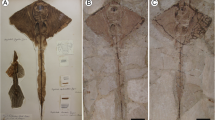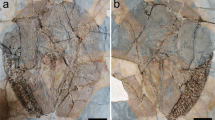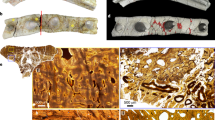Abstract
Rays (Batoidea) possess some of the absolutely largest dermal elements of any cartilaginous fish. One of the largest known batoid dermal elements is an isolated fossil tubercle originally interpreted as a manta ray caudal stinger and named Ceratoptera unios Leidy, 1877 from an unknown locality near Charleston, South Carolina. Though recently considered to be a stingray (Dasyatidae), the lack of stratigraphic provenience for the specimen has hampered attempts to identify it. A new collection of gigantic dermal tubercles and bucklers from the Lower Pleistocene Waccamaw Formation of South Carolina includes mid-dorsal tubercles similar in morphology to “Ceratoptera unios” and dermal bucklers similar in morphology to those of the extant roughtail stingray Bathytoshia centroura (Mitchill, 1815). Mid-dorsal tubercles and bucklers suggest gigantic stingrays in excess of 3 m disc width. These new specimens suggest that C. unios may have originated from upper Pliocene or Pleistocene deposits, and possible synonymy with Bathytoshia centroura, pending careful study of extant dasyatid dermal elements.

Similar content being viewed by others
Data availability
All specimens studied herein are curated within established natural history museums.
Code availability
Not applicable.
References
Albright, L.B., A.E. Sanders, R.E. Weems, D.J. Cicimurri, and J.L. Knight. 2019. Cenozoic vertebrate biostratigraphy of South Carolina, U.S.A., and additions to the fauna. Bulletin of the Florida Museum 57: 77–236.
Albright, L.B., A.E. Sanders, and J.H. Geisler. 2018. An unexpectedly derived odontocete from the Ashley Formation (upper Rupelian) of South Carolina, U.S.A. Journal of Vertebrate Paleontology 38: e1482555.
Başusta, N., and J.A. Sulikowski. 2012. The oldest estimated age for roughtail stingray [Dasyatis centroura (Mitchill, 1815)] from the Mediterranean Sea. Applied Ichthyology 28: 641–642.
Bigelow, H.B., and W.C. Schroeder. 1953. Fishes of the Western North Atlantic, part two: Sawfishes, Guitarfishes, Skates and Rays. Memoir of the Sears Foundation for Marine Research 1 (2): 1–588.
Boessenecker, R.W., and S.J. Boessenecker. 2019. Paleontology of the “Ashley Phosphate Beds” of Charleston: Insights from Northbridge Park, Charleston, South Carolina. Geological Society of America Field Guide 53: 1–8.
Boessenecker, S.J., R.W. Boessenecker, and J.H. Geisler. 2018. Youngest record of the extinct walrus Ontocetus emmonsi from the early Pleistocene of South Carolina and a review of North Atlantic walrus biochronology. Acta Palaeontologica Polonica 63 (2): 279–286.
Bor, T., T. Reinecke, and S. Verschueren. 2012. Miocene Chondrichthyes from Winterswik-Miste, The Netherlands. Palaeontos 21: 1–136.
Collareta, A., M. Merella, S. Casati, and A. Di Cencio. 2020. Did titanic stingrays wander the Pliocene Mediterranean Sea? Some notes on a giant-sized myliobatoid stinger from the Piacenzian of Italy. Neues Jahrbuch für Geologie und Paläontologie, Abhandlungen 298: 155–164.
Compagno, L.J.V. 1973. Interrelationships of living elasmobranchs. In Interrelationships of fishes, eds. P.H. Greenwood, R.S. Miles, and C. Patterson, 15–61. New York, N.Y.: Academic Press.
Deynat, P.P. 1998. Le revetement cutané des raies (Chondrichthyes, Elasmobranchii, Batoidea). II. Morphologie et arrangement des tubercules cutanés. Annales des Sciences naturelles 3–4: 155–172.
Huxley, T.H. 1880. On the application of the laws of evolution to the arrangement of the Vertebrata and more particularly of the Mammalia. Proceedings of the Zoological Society of London 1880: 649–662.
Jordan, D.S. 1888. Description of two new species of fishes from South America. Proceedings of the Academy of Natural Sciences of Philadelphia 39: 387–388.
Jordan, D.S., and C.H. Gilbert. 1879. Notes on the fishes of Beaufort Harbor, North Carolina. Proceedings of the United States National Museum 1: 365–388.
Last, P.R., G.J.P. Naylor, and B.M. Manjaji-Matsumoto. 2016. A revised classification of the family Dasyatidae (Chondrichthyes: Myliobatiformes) based on new morphological and molecular insights. Zootaxa 4139: 345–368.
Leidy, J. 1876. Remarks on fossils of the Ashley Phosphate Beds. Proceedings of the Academy of Natural Sciences of Philadelphia 28: 86–87.
Leidy, J. 1877. Description of vertebrate remains, chiefly from the phosphate beds of South Carolina. Journal of the Academy of Natural Sciences of Philadelphia 8(2): 209–261.
Mitchill, S.L. 1815. The fishes of New York described and arranged. Transactions of the Literary and Philosophical Society of New York 1: 355–492.
Purdy, R.W., V.P. Schneider, S.P. Applegate, J.H. McLellan, R.L. Meyer, and B.H. Slaughter. 2001. The Neogene sharks, rays, and bony fishes from Lee Creek Mine, Aurora, North Carolina. Smithsonian Contributions to Paleobiology 90: 71–202.
Reif, W.E. 1979. Morphogenesis and histology of large scales of batoids (Elasmobranchii). Paläontologische Zeitschrift 53: 26–37.
Sanders, A.E. 2002. Additions to the Pleistocene mammal faunas of South Carolina, North Carolina, and Georgia. Transactions of the American Philosophical Society 92: 1–152.
Schwartz, F.J., J. Purifoy, G. Safrit, and C. Lewis. 2010. Status of roughtail stingray, Dasyatis centroura, off North Carolina. Journal of the North Carolina Academy of Science 126: 64–66.
Silas, E.G., and G.S.D. Selvaraj. 1985. On the occurrence of the rough-tail sting-ray Dasyatis centroura (Mitchill) in Indian waters. Indian Journal of Fisheries 32: 248–255.
Whitley, G.P. 1933. Studies in ichthyology. No. 7. Records of the South Australian Museum 19: 60–112.
Acknowledgements
This study would not have been possible without the generosity of Sam Davis, Ashby Gale and Jordan Taylor, Ivan Tomkins, and Bricky Way, who kindly donated the specimens reported herein. We would like to thank James Austin for field access and Sarah Boessenecker, Mark Bunce, Ashby Gale, and Jordan Taylor for field assistance at Austin Sand Pit #2. This study benefited from discussions on South Carolina stratigraphy and paleontology with Ashby Gale and Rob Weems. Thanks to J. Peragine (Charleston Museum) and Sarah Boessenecker (CCNHM), who facilitated study of specimens under their care. This study benefited greatly from constructive reviews by J. Carrillo-Briceño and A. Collareta and comments from the editors.
Funding
Not applicable.
Author information
Authors and Affiliations
Corresponding author
Ethics declarations
Conflict of interest
Not applicable.
Additional information
Handling Editor: Jürgen Kriwet.
Rights and permissions
About this article
Cite this article
Boessenecker, R.W., Gibson, M.L. Dermal tubercles and bucklers of gigantic stingrays (Dasyatidae) from the Pleistocene of South Carolina and the stratigraphic origin of “Ceratoptera unios” Leidy, 1877. PalZ 96, 267–273 (2022). https://doi.org/10.1007/s12542-021-00592-5
Received:
Accepted:
Published:
Issue Date:
DOI: https://doi.org/10.1007/s12542-021-00592-5





